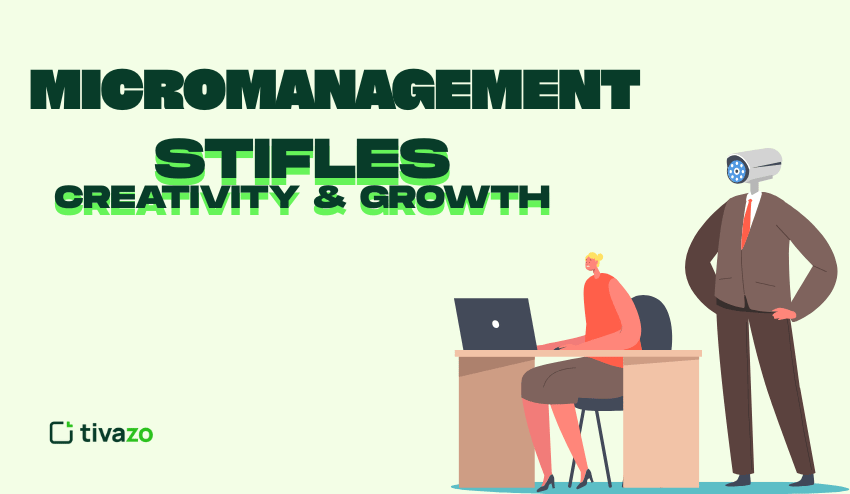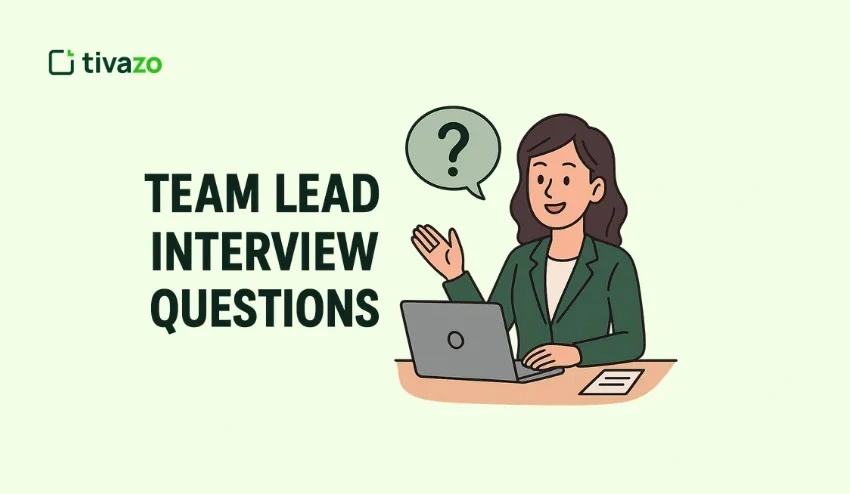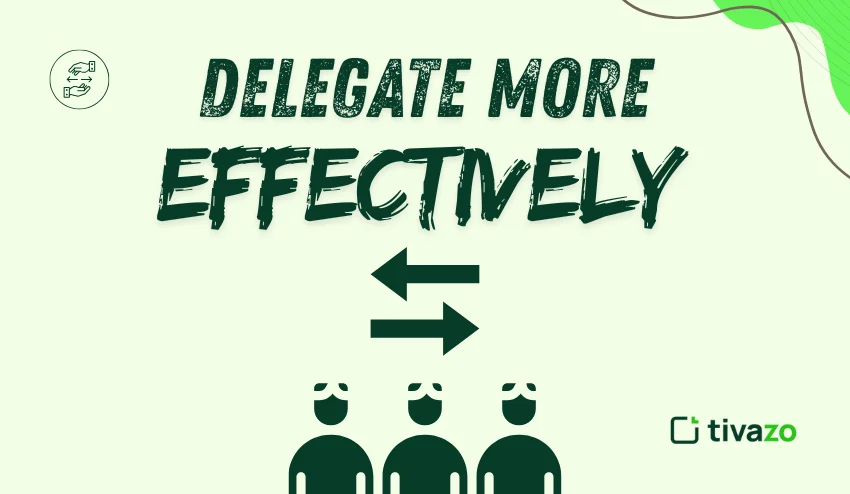Micromanagement limits creativity and growth—this is an absolute. In the modern workforce, leaders might very well obsess over the details of everything that everyone does, but when this happens, the employee will have no autonomy, no chance to be creative, and they will not be able to grow, and the outcome is stagnation and declining morale in their work. Within this blog, we will explore 7 shocking (3-5 meaningful) ways that micromanagement limits creativity and growth, we will answer readers’ most pressing questions, and we will help both individuals and organizations find a healthier way to lead their workspace.
Key Highlights:
- Does micromanagement stifle creativity and growth?
- True or False: Micromanagement stops creativity and growth?
- What characteristics define a micromanager?
- How Micromanagement Hurts
- Look for these red flags:
- The Bright Side of Micromanagement
- Underlying Causes of Micromanagement
- How Micromanagement Limits Creativity and Development
Does micromanagement stifle creativity and growth?
Yes—micromanagement stifles creativity and growth because it diminishes autonomy, breeds fear, and inhibits innovation. Several studies have shown that when a leader exercises excessive control, their employees may become hesitant to take chances or consider any novel ideas. In a context where employees believe their work doesn’t matter, the likelihood that they become disengaged is probable, and, without motivated employees, the risk of stagnation increases. In the end, if done consistently, micromanagement stifles creativity and growth.
It fosters a workplace culture of playing it safe, following poorly structured instructions, and avoiding both high-risk and high-reward tasks. Restrictions on individual development and company growth often converge, which contributes to organizational inertia—the slow condition of a company that struggles to innovate and adapt for any sustainable, competitive advantage.
True or False: Micromanagement stops creativity and growth?
True. Studies have shown time and again, in all industries, cultures, teams, job functions, and other dimensions, that micromanagement stifles creativity and growth preventing creativity and growth. Leaders who manage each task with excessive monitoring and behavior in hopes of ensuring quality and efficiency have only limited growth and creativity results.
Here’s how:
- Limits Innovation—if leaders are going to dictate every detail, there isn’t an opportunity for new perspectives or innovative problem solving.
- Erodes Trust—if leaders don’t give the people they lead the opportunity to make decisions, trust is reduced, confidence is lost, and initiative decreases.
- Slows Growth—skills stagnate if people do not have autonomy, accompanied by the capacity to learn through trial and error.
- Increases Turnover—at some point, talented individuals will leave organizations where micromanagement is the norm in search of an environment that values autonomy, collaborative working, and creative solutions.
In summary, micromanagement stifles creativity and growth, hindering creativity and growth because it replaces empowerment with fear, collaboration with control, and innovation with rigid compliance. For organizations seeking sustainable success, it is prudent to abandon micromanagement and provide autonomy.
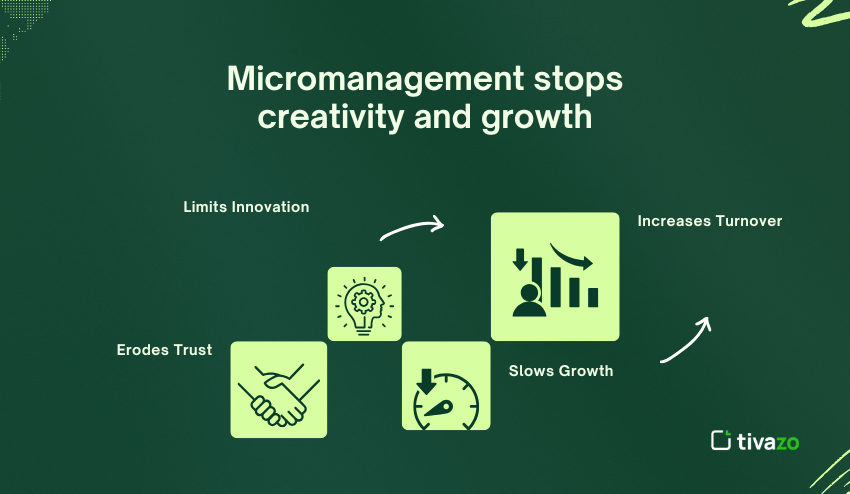
What characteristics define a micromanager?
Micromanagers often exhibit specific traits that explain how their micromanagement stifles creativity and growth, impacting behaviors, which stifles creativity and inhibits growth. Typical traits displayed by micromanagers include:
- Insecurity: They are often insecure about making mistakes and, therefore, attempt to control everything.
- Fear of Failure: They are often unable to take risks and restrict the behaviors of team members when exploring new ideas or methodologies.
- Perfectionism: They tend to feel that only their way is the right way of fixing a problem, and it squelches creative thinking by employees.
- Lack of Trust: They have a lot of difficulty trusting the work quality of another individual unless they closely supervise them.
- Narcissistic Tendencies: They are focused on keeping their authority instead of empowering the team.
- Manipulative Delegation: Gives an employee a task, but not the whole decision-making power, which can create frustration.
- Overly Directive: They provide direction step by step. They exert total control and do not allow independence in thinking or blocking a creative path.
These traits highlight how micromanagement stifles creativity and growth; they substitute control for autonomy, fear for innovation, and dependency for team collaboration.
How Micromanagement Hurts
Micromanagement stifles creativity and growth in many ways:
| Effect | Description |
| Stress & Burnout | Workers are under constant observation, and this increases anxiety and is fatiguing. |
| Low Morale & Motivation | Lack of confidence and autonomy reduces satisfaction with work. |
| Lower Productivity | Slows down decisions and tasks, as they wait for approvals to move forward. |
| High Turnover | Disengaged employees are resigned to leave if unsatisfied. |
| Suppressed Innovation | Risk aversion kills creativity, and groupthink homogenizes new ideas. |
Look for these red flags:
- Requests frequent updates and detailed documentation
- Avoids delegating and does not trust other people
- Wants to control the smallest details and micromanages the processes
- Second-guesses work, or wants to rewrite the work
- Unable to trust someone who takes away the autonomy of the individual
- Any signs of stress in the individual(s) – tension, burnout, etc.
These types of behaviors are the first indicators that micromanagement stifles creativity and growth, holding back individuals and teams from being creative and developing. When leaders are focused on the tiny details all of the time, it creates a lack of trust in their employees, and since employees feel like their opinions and decisions are of no value to their employer, it begins to create an environment where they have fear, little to no motivation, and no longer think outside of the box.
Over time, working in an environment conducive to micromanagement stifles creativity and growth becomes stifling and prevents development and growth. It is important for leaders to understand the signs of micromanagement, because it is not only detrimental to the development and growth of their employees, but a number of individuals in the organization. Eventually, it will slow down the course of action for the entire organization overall. Micromanagement stifles creativity and growth, which is truly debilitating.
The Bright Side of Micromanagement
While micromanagement can kill creativity and growth, there are instances where a little direction may not be a bad thing. Recognizing these occasions can allow leaders to engage in micromanagement without stifling creativity and growth with greater effectiveness and less of a negative connotation.
1. Ensuring Compliance and Control
In a High-Risk Environment, in cases of catastrophic failure where the price of getting something wrong could have dire consequences, like aviation, healthcare, and finance, strict oversight will ensure safety and compliance with regulatory requirements. This is a case where micromanagement stifles creativity and growth, preventing very costly mistakes without strictly killing overall creativity.
2. Providing Structure and Confidence
Hourly New Employees and Interns, when hiring an inexperienced employee or an intern, they may need very close trackable guidance as they learn workflows and their roles. Often, some micromanagement in the beginning will allow employees to learn their skills much faster, build confidence, and seize opportunities for self-direction.
3. Managing A Crisis
That adheres to Stipulations that require compliance and rigor, A time-sensitive emergency where the details of directives must be implemented as intended becomes a high-performing team exercise that cites attention to detail and accuracy as a method of preventing mistakes and producing a deliverable that meets the quality standard.
Still, even given these situations, you must keep in mind that extended micromanagement stifles creativity and growth. It should be the goal of every leader to step down their oversight and monitoring to allow employees to improvise, make decisions autonomously, and ultimately contribute to the collective success of the organization and the team.
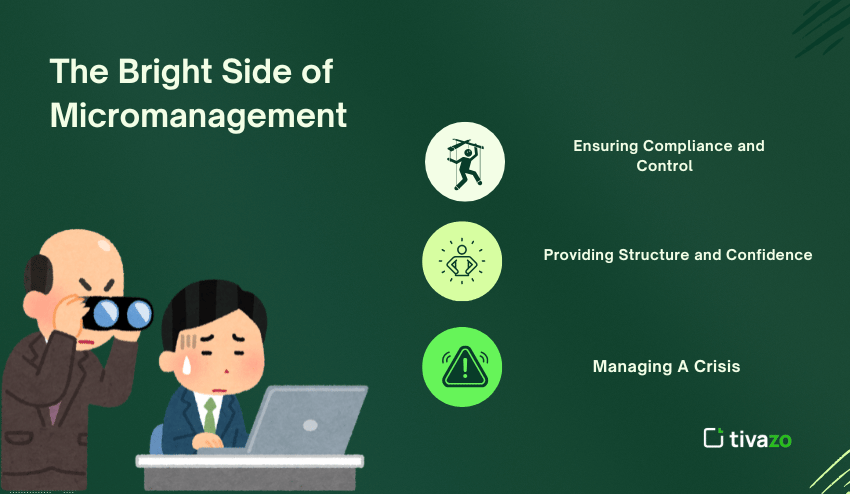
Underlying Causes of Micromanagement
- Micromanagement is often caused by deeper psychological and organizational issues that lead to micromanagement stifles creativity and growth.
- Fear of Losing Control: When leaders aren’t watching every decision in their work environment, they may believe mistakes happen, resulting in failure.
- Desiring Perfection, Avoiding Risk: When leaders want to avoid mistakes or have process perfection, they may not trust their staff to be innovative or take initiative.
- Insecurity or Lack of Confidence in Others: When leaders feel insecure in the capabilities of their team, they will micromanage, which is a top reason why micromanagement stifles creativity and growth.
- Pressure from Upper Management: High expectations or performance targets require leaders to micromanage to guarantee results.
- Recognizing these underlying causes is important to address micromanagement and build an organizational culture of autonomy, innovation, and sustainable growth.
How to Know If Your Boss Is a Micromanager
Knowing how to identify micromanagement stifles creativity and growth, an important aspect, as it generally reduces both collective and individual creativity, as well as growth. While some indicators are easy to identify, there are also more nuanced indicators that suggest a boss may be a micromanager:
1. Excessive amounts of monitoring and checking in
If your boss asks you for a progress report on a mundane task and continues to press you, this is a sign that they do not trust you. This level of oversight is limited, decreases your autonomy, and your ability to act confidently.
2. Doesn’t delegate work
A micromanager has a lot of tasks that they could hand off to you or another team member, but they would rather keep the work. This also comes at the cost of your development, such as learning and managing a task.
3. Disproportionate criticism
- Overemphasis on mistakes encourages inaction and discourages new ideas. When your boss focuses intensely on mistakes, employees are less likely to offer new ideas for your team.
- Employees worry about their decisions: When a team member feels anxiety about making decisions that involve some level of judgment, they will stop experimenting or innovating.
A few subtle signs are your boss redoing your work without you knowing, requiring a signature in any situation, even with nominal values, and giving you very specific instructions on how they want an outcome to look. These behaviors all clearly illustrate how micromanagement stifles creativity and growth, restricting creativity and growth, which is also correlated to productivity, engagement, and organizational innovation.
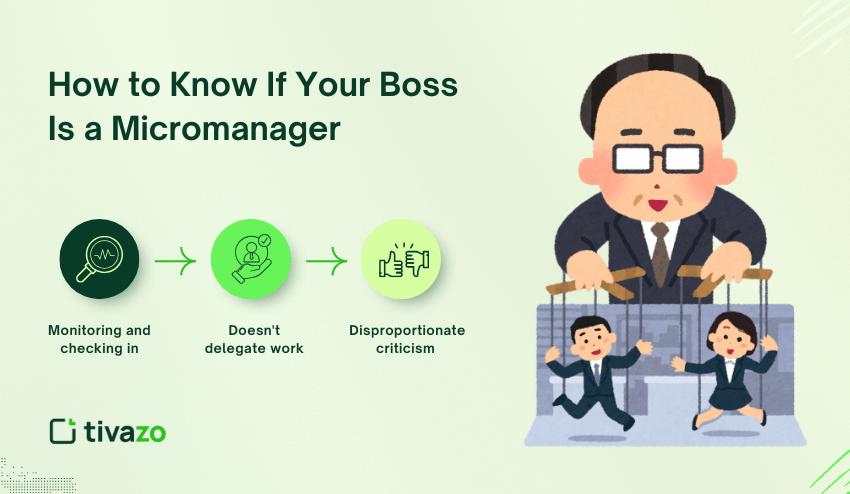
How Micromanagement Limits Creativity and Development
1. Erases Autonomy
Micromanagement stifles creativity and development by eliminating employee decision-making ability, pushing employees away from engagement and participation. The team loses autonomy and ownership of a task. Motivation and innovation decrease because the team is no longer making any choices.
2. Creates a Culture of Fear
A fear-based organization does not allow risk-taking, and without risk-taking, innovation stops. In this type of environment, the workforce is focused on avoiding making mistakes rather than trying to be creative, meaning that micromanagement stifles creativity and growth, even development across both the individual and the organization.
3. Takes Creativity Out of Creative Thinking
The workforce chooses predictable, safe, no-risk ideas rather than bold, innovative ideas. Over time, this education disengagement suppresses creative problem-solving and restricts longer-term progress.
4. Increases Stress and Burnout
Continuous monitoring is draining and can potentially lower performance and creativity. High levels of stress lead to fewer employees willing to experiment and offer new ideas.
5. Slows Down Projects
The process of obtaining approval from multiple layers, or levels, can slow down a project and create friction. This inefficiency is another way that micromanagement stifles creativity and growth because opportunities are often sacrificed to slow decision-making.
6. Damages employee morale
Micromanagement stifles creativity and growth by wasting time, eroding trust, and making good employees disengage. When teams feel belittled, they will often disregard what they are doing and will have a higher turnover rate.
7. Eliminates security to share ideas
Without some sense of safety to share ideas, innovation is absent. Employees will hesitate to suggest non-conventional ideas, so the process of micromanagement stifles creativity and growth, discouraging creativity and growth in the modern workplace.
8. Stifles skill development
Micromanagers impede the “learning through experience” channel every time they control every facet. Not only is the individual’s professional development stalled, but the organization’s mindshare is also hampered.
9. Reduces Collaborative Skills
Micromanagement breeds dependence on management and will limit the group from collaborating both cross-functionally and from sharing a learning environment. If people are afraid to contribute tacit knowledge, this micromanagement stifles creativity and growth for the entire ecosystem of the team.
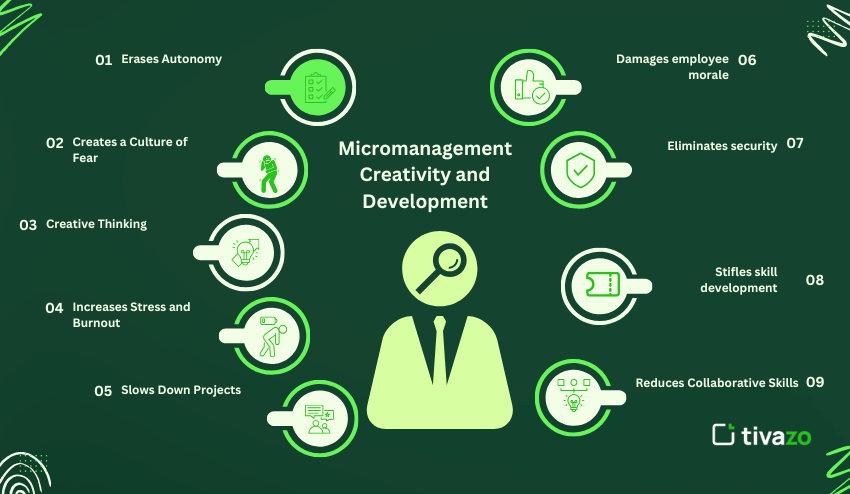
Conclusion
Micromanagement diminishes creativity and growth. It takes away autonomy, creates fear, adds mental health burden, and inhibits innovation. There is a way to change to a better approach: by recognizing patterns of micromanagement and shifting to empowering, trustworthy, impactful leadership. Empowering autonomy, maintaining mental safety, delegating appropriately, and encouraging the risk of thinking outside of the box will allow people and the organization to flourish.
Moreover, being aware of how micromanagement stifles creativity and growth enables a leader to spot the signs of destructive patterns quickly and make the moves necessary to address them. Establishing a climate of trust and collaboration builds a culture of employees who feel valued and appreciated, motivated, and free to find new ideas. Once leaders start to actively reduce and eliminate circumstances that represent micromanaging, creativity and growth can flourish, the barriers to reaching their full potential can come down, and the ability to create lasting success can begin.
